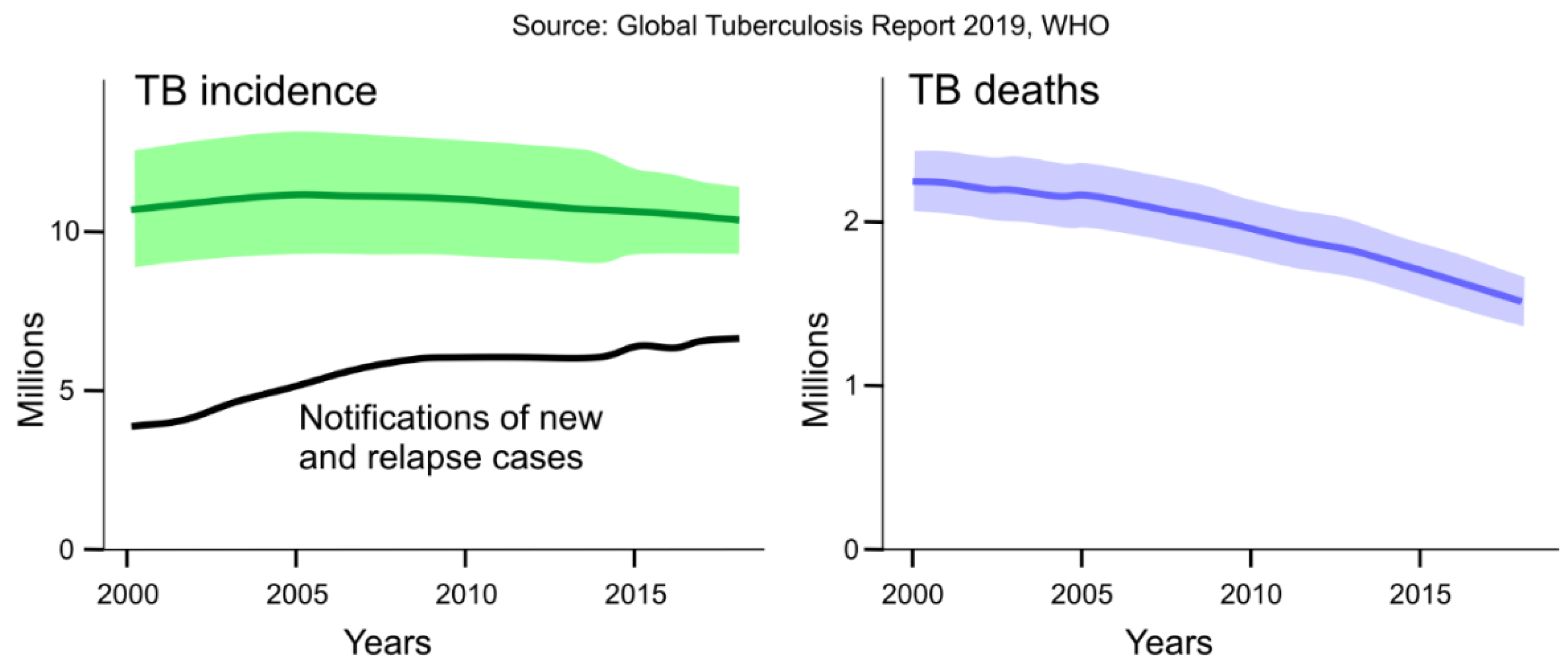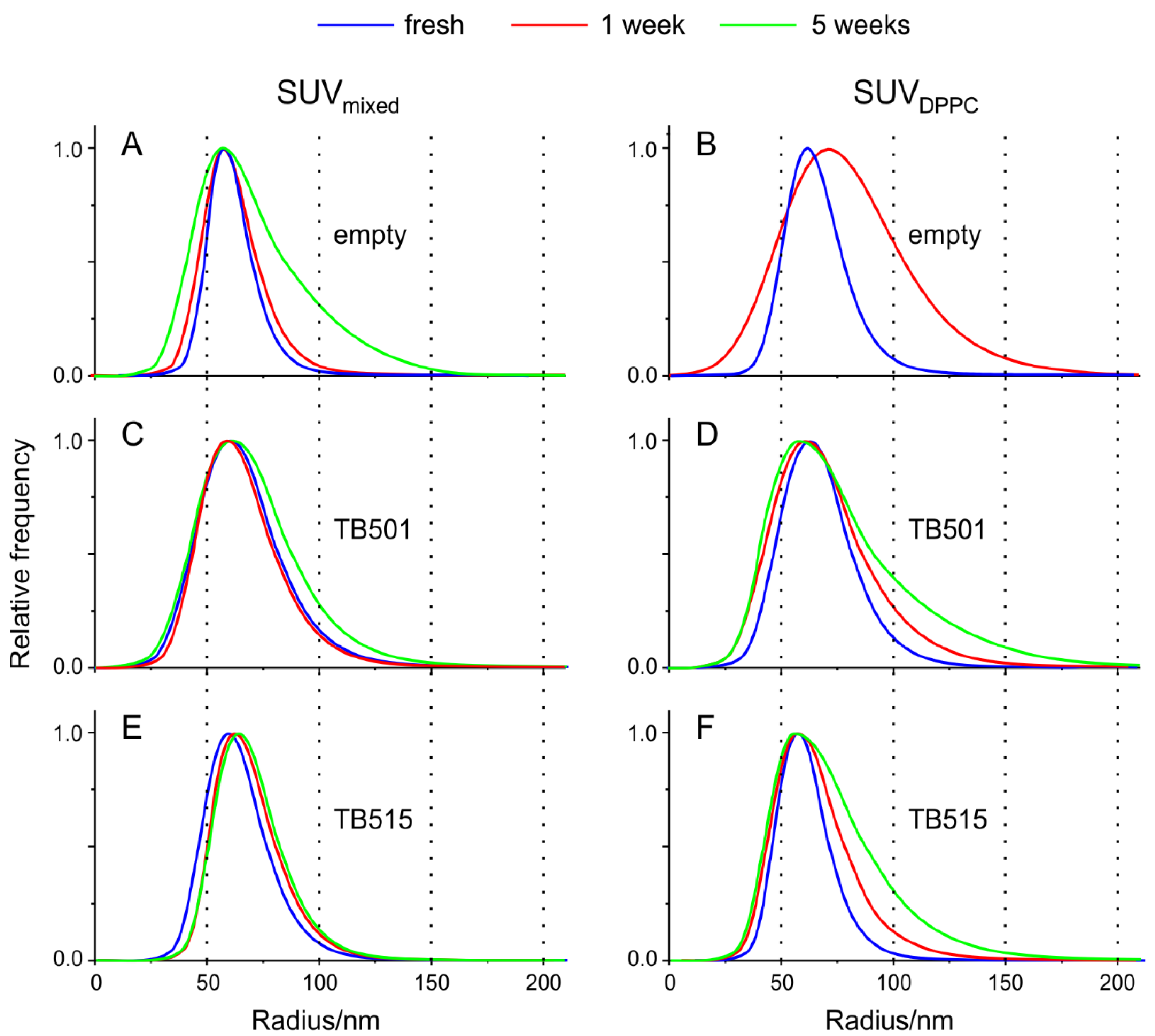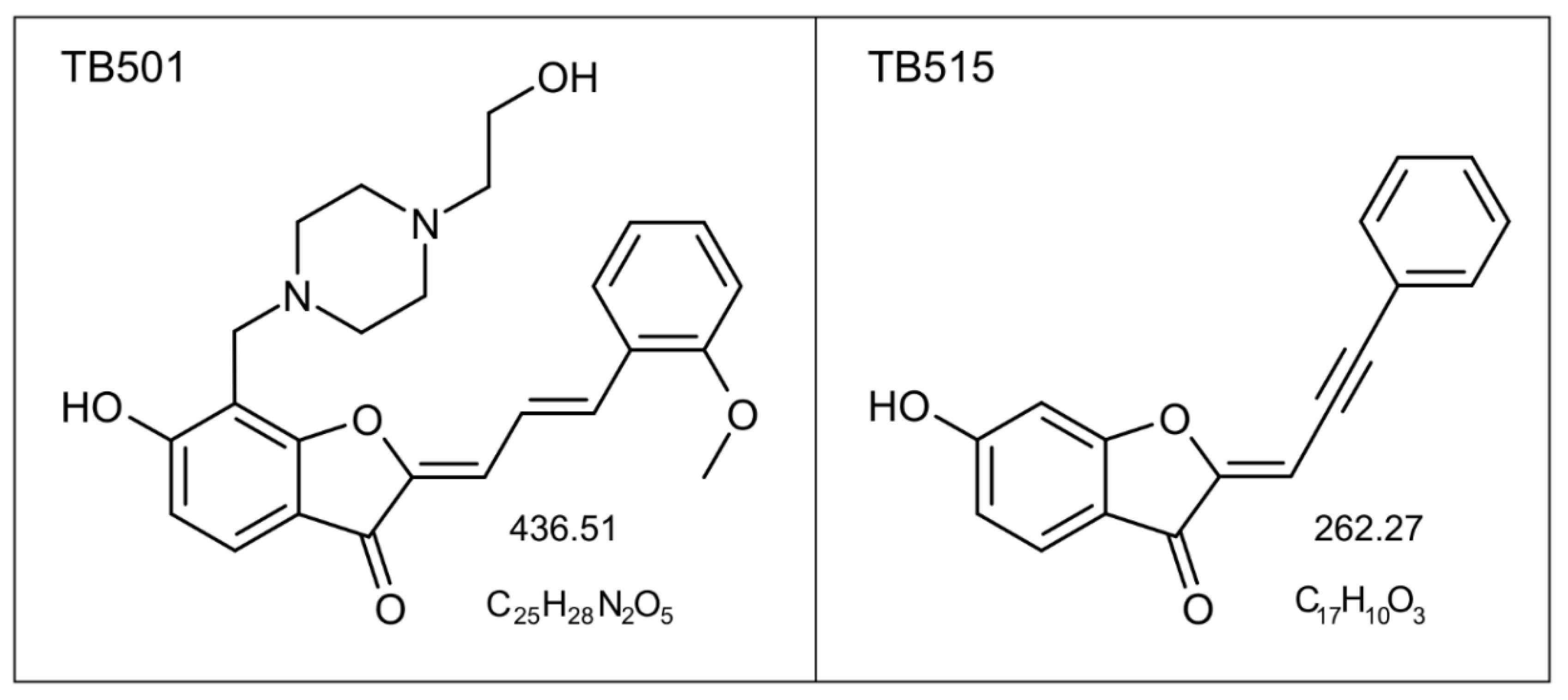Comparison of the Efficacy of Two Novel Antitubercular Agents in Free and Liposome-Encapsulated Formulations
Abstract
1. Introduction
2. Results
2.1. Physicochemical Characterization of Liposome Samples
2.1.1. Homogeneity and Long-Term Stability
2.1.2. Encapsulation Efficiency
2.2. In Vitro Cellular Uptake and Cell Viability
2.3. Intracellular Efficacy on Infected Host Cells
3. Discussion
4. Materials and Methods
4.1. Chemicals
4.2. Preparation of Liposomes
4.3. Dynamic Light Scattering
4.4. Size Exclusion Chromatography and Absorption Spectrometry
4.5. Assessment of In Vitro Cellular Uptake and Cytotoxicity Using Flow Cytometry
4.6. In Vitro Cytotoxicity Determination by Colorimetric MTT-Assay
4.7. Determination of In Vitro Antitubercular Efficacy of the Compounds on Mycobacterial Cultures and Infected Monocytes
5. Conclusions
Author Contributions
Funding
Acknowledgments
Conflicts of Interest
References
- World Health Organization. Global Tuberculosis Report 2019; Licence: CC BY-NC-SA 3.0 IGO; World Health Organization: Geneva, Switzerland, 2019. [Google Scholar]
- Mase, S.R.; Chorba, T. Treatment of Drug-Resistant Tuberculosis. Clin. Chest Med. 2019, 40, 775–795. [Google Scholar] [CrossRef] [PubMed]
- Lee, A.; Xie, Y.L.; Barry, C.E.; Chen, R.Y. Current and future treatments for tuberculosis. BMJ 2020, 368. [Google Scholar] [CrossRef]
- Kurz, S.G.; Furin, J.J.; Bark, C.M. Drug-Resistant Tuberculosis: Challenges and Progress. Infect. Dis. Clin. N. Am. 2016, 30, 509–522. [Google Scholar] [CrossRef]
- Pinheiro, M.; Lucio, M.; Lima, J.L.F.C.; Reis, S. Liposomes As Drug Delivery Systems for the Treatment of TB. Nanomedicine 2011, 6, 1413–1428. [Google Scholar] [CrossRef]
- Alipanah, N.; Jarlsberg, L.; Miller, C.; Linh, N.N.; Falzon, D.; Jaramillo, E.; Nahid, P. Adherence interventions and outcomes of tuberculosis treatment: A systematic review and meta-analysis of trials and observational studies. PLoS Med. 2018, 15. [Google Scholar] [CrossRef] [PubMed]
- Rabahi, M.F.; Júnior Rodrigues da Silva, J.L.; Ferreira, A.C.G.; Tannus-Silva, D.G.S.; Conde, M.B. Tuberculosis Treatment. Int. Encycl. Public Health 2016, 43, 267–276. [Google Scholar] [CrossRef]
- Sassetti, C.M.; Boyd, D.H.; Rubin, E.J. Genes required for mycobacterial growth defined by high density mutagenesis. Mol. Microbiol. 2003, 48, 77–84. [Google Scholar] [CrossRef] [PubMed]
- Mészáros, B.; Tóth, J.; Vértessy, B.G.; Dosztányi, Z.; Simon, I. Proteins with complex architecture as potential targets for drug design: A case study of Mycobacterium tuberculosis. PLoS Comput. Biol. 2011, 7. [Google Scholar] [CrossRef]
- Nagy, G.N.; Leveles, I.; Vértessy, B.G. Preventive DNA repair by sanitizing the cellular (deoxy)nucleoside triphosphate pool. FEBS J. 2014, 281, 4207–4223. [Google Scholar] [CrossRef] [PubMed]
- Varga, B.; Barabás, O.; Takács, E.; Nagy, N.; Nagy, P.; Vértessy, B.G. Active site of mycobacterial dUTPase: Structural characteristics and a built-in sensor. Biochem. Biophys. Res. Commun. 2008, 373, 8–13. [Google Scholar] [CrossRef]
- Mizrahi, V.; Andersen, S.J. DNA repair in Mycobacterium tuberculosis. What have we learnt from the genome sequence? Mol. Microbiol. 1998, 29, 1331–1339. [Google Scholar] [CrossRef]
- Chan, S.; Segelke, B.; Lekin, T.; Krupka, H.; Cho, U.S.; Kim, M.Y.; So, M.; Kim, C.Y.; Naranjo, C.M.; Rogers, Y.C.; et al. Crystal structure of the Mycobacterium tuberculosis dUTPase: Insights into the catalytic mechanism. J. Mol. Biol. 2004, 341, 503–517. [Google Scholar] [CrossRef]
- Takács, E.; Nagy, G.; Leveles, I.; Harmat, V.; Lopata, A.; Tóth, J.; Vértessy, B.G. Direct contacts between conserved motifs of different subunits provide major contribution to active site organization in human and mycobacterial dUTPases. FEBS Lett. 2010, 584, 3047–3054. [Google Scholar] [CrossRef]
- Lipinski, C.A. Drug-like properties and the causes of poor solubility and poor permeability. J. Pharmacol. Toxicol. Methods 2000, 44, 235–249. [Google Scholar] [CrossRef]
- Scheich, C.; Szabadka, Z.; Vértessy, B.; Pütter, V.; Grolmusz, V.; Schade, M. Discovery of novel MDR-mycobacterium tuberculosis inhibitor by new FRIGATE computational screen. PLoS ONE 2011, 6, 1–9. [Google Scholar] [CrossRef]
- Horváti, K.; Bacsa, B.; Szabó, N.; Dávid, S.; Mezo, G.; Grolmusz, V.; Vértessy, B.; Hudecz, F.; Bosze, S. Enhanced cellular uptake of a new, in silico identified antitubercular candidate by peptide conjugation. Bioconjug. Chem. 2012, 23, 900–907. [Google Scholar] [CrossRef] [PubMed]
- Irwin, J.J.; Shoichet, B.K. ZINC—A Free Database of Commercially Available Compounds for Virtual Screening. J. Chem. Inf. Model. 2005, 45, 177–182. [Google Scholar] [CrossRef] [PubMed]
- Irwin, J.J.; Sterling, T.; Mysinger, M.M.; Bolstad, E.S.; Coleman, R.G. ZINC: A free tool to discover chemistry for biology. J. Chem. Inf. Model. 2012, 52, 1757–1768. [Google Scholar] [CrossRef]
- Lipinski, C.A.; Lombardo, F.; Dominy, B.W.; Feeney, P.J. Experimental and computational approaches to estimate solubility and permeability in drug discovery and development settings. Adv. Drug Deliv. Rev. 1997, 23, 3–25. [Google Scholar] [CrossRef]
- Zsila, F.; Bősze, S.; Beke-Somfai, T. Interaction of antitubercular drug candidates with α1-acid glycoprotein produced in pulmonary granulomas. Int. J. Biol. Macromol. 2020, 147, 1318–1327. [Google Scholar] [CrossRef] [PubMed]
- Kiss, É.; Gyulai, G.; Pénzes, C.B.; Idei, M.; Horváti, K.; Bacsa, B.; Bosze, S. Tuneable surface modification of PLGA nanoparticles carrying new antitubercular drug candidate. Colloids Surfaces A Physicochem. Eng. Asp. 2014, 458, 178–186. [Google Scholar] [CrossRef]
- Horváti, K.; Gyulai, G.; Csámpai, A.; Rohonczy, J.; Kiss, É.; Bösze, S. Surface Layer Modification of Poly(d, l -lactic- co-glycolic acid) Nanoparticles with Targeting Peptide: A Convenient Synthetic Route for Pluronic F127-Tuftsin Conjugate. Bioconjug. Chem. 2018, 29, 1495–1499. [Google Scholar] [CrossRef]
- Ibrahim Bekraki, A. Chapter 7—Liposomes-and niosomes-based drug delivery systems for tuberculosis treatment. In Nanotechnology Based Approaches for Tuberculosis Treatment; Kesharwani, P., Ed.; Academic Press: Cambridge, MA, USA, 2020; pp. 107–122. ISBN 978-0-12-819811-7. [Google Scholar]
- Donnellan, S.; Giardiello, M. Nanomedicines towards targeting intracellular Mtb for the treatment of tuberculosis. J. Interdiscip. Nanomed. 2019, 4, 76–85. [Google Scholar] [CrossRef]
- Zhang, R.; Qin, X.; Kong, F.; Chen, P.; Pan, G. Improving cellular uptake of therapeutic entities through interaction with components of cell membrane. Drug Deliv. 2019, 26, 328–342. [Google Scholar] [CrossRef]
- Lira, M.C.B.; Siqueira-Moura, M.P.; Rolim-Santos, H.M.L.; Galetti, F.C.S.; Simioni, A.R.; Santos, N.P.; Tabosa Do Egito, E.S.; Silva, C.L.; Tedesco, A.C.; Santos-Magalhães, N.S. In vitrouptake and antimycobacterial activity of liposomal usnic acid formulation. J. Liposome Res. 2009, 19, 49–58. [Google Scholar] [CrossRef]
- Akbarzadeh, A.; Rezaei-Sadabady, R.; Davaran, S.; Joo, S.W.; Zarghami, N.; Hanifehpour, Y.; Samiei, M.; Kouhi, M.; Nejati-Koshki, K. Liposome: Classification, preparation, and applications. Nanoscale Res. Lett. 2013, 8, 1. [Google Scholar] [CrossRef]
- Bulbake, U.; Doppalapudi, S.; Kommineni, N.; Khan, W. Liposomal formulations in clinical use: An updated review. Pharmaceutics 2017, 9, 12. [Google Scholar] [CrossRef] [PubMed]
- Paliwal, S.R.; Paliwal, R.; Vyas, S.P. A review of mechanistic insight and application of pH-sensitive liposomes in drug delivery. Drug Deliv. 2015, 22, 231–242. [Google Scholar] [CrossRef] [PubMed]
- Immordino, M.L.; Dosio, F.; Cattel, L. Stealth liposomes: Review of the basic science, rationale, and clinical applications, existing and potential. Int. J. Nanomed. 2006, 1, 297–315. [Google Scholar]
- Suk, J.S.; Xu, Q.; Kim, N.; Hanes, J.; Ensign, L.M.; Sciences, H.; Sciences, M. PEGylation as a strategy for improving nanoparticle-based drug and gene delivery. Adv. Drug Deliv. Rev. 2017, 99, 28–51. [Google Scholar] [CrossRef]
- Mohamed, M.; Abu Lila, A.S.; Shimizu, T.; Alaaeldin, E.; Hussein, A.; Sarhan, H.A.; Szebeni, J.; Ishida, T. PEGylated liposomes: Immunological responses. Sci. Technol. Adv. Mater. 2019, 20, 710–724. [Google Scholar] [CrossRef] [PubMed]
- Horváti, K.; Bacsa, B.; Szabó, N.; Fodor, K.; Balka, G.; Rusvai, M.; Kiss, É.; Mezo, G.; Grolmusz, V.; Vértessy, B.; et al. Antimycobacterial activity of peptide conjugate of pyridopyrimidine derivative against Mycobacterium tuberculosis in a series of in vitro and in vivo models. Tuberculosis 2015, 95, S207–S211. [Google Scholar] [CrossRef] [PubMed][Green Version]
- Kapus, A.; Grinstein, S.; Wasan, S.; Kandasamy, R.; Orlowski, J. Functional characterization of three isoforms of the Na+/H+ exchanger stably expressed in Chinese hamster ovary cells. ATP dependence, osmotic sensitivity, and role in cell proliferation. J. Biol. Chem. 1994, 269, 23544–23552. [Google Scholar] [CrossRef]
- Dua, J.S.; Rana, A.C.; Bhandari, A.K. Liposomes—Methodology and applications. Front. Biol. 1979, 48, 549–574. [Google Scholar]
- Simões, S.; Slepunshkin, V.; Düzgünes, N.; Pedroso de Lima, M.C. On the mechanisms of internalization and intracellular delivery mediated by pH-sensitive liposomes. Biochim. Biophys. Acta Biomembr. 2001, 1515, 23–37. [Google Scholar] [CrossRef]
- Bőcskei-Antal, B.; Zolcsák, Á.; Kósa, N.; Voszka, I.; Csík, G.; Tóth, K.; Herenyi, L. Comparison of light-induced formation of reactive oxygen species and the membrane destruction of two mesoporphyrin derivatives in liposomes. Sci. Rep. 2019, 9, 1–10. [Google Scholar] [CrossRef] [PubMed]
- Módos, K.; Galántai, R.; Bárdos-Nagy, I.; Wachsmuth, M.; Tóth, K.; Fidy, J.; Langowski, J. Maximum-entropy decomposition of fluorescence correlation spectroscopy data: Application to liposome-human serum albumin association. Eur. Biophys. J. 2004, 33, 59–67. [Google Scholar] [CrossRef] [PubMed]
- Grabielle-Madelmont, C.; Lesieur, S.; Ollivon, M. Characterization of loaded liposomes by size exclusion chromatography. J. Biochem. Biophys. Methods 2003, 56, 189–217. [Google Scholar] [CrossRef]
- Ruysschaert, T.; Marque, A.; Duteyrat, J.L.; Lesieur, S.; Winterhalter, M.; Fournier, D. Liposome retention in size exclusion chromatography. BMC Biotechnol. 2005, 5, 1–13. [Google Scholar] [CrossRef]
- Ziegler-Heitbroc, H.W.L.; Thiel, E.; Futterer, A.; Herzog, V.; Wirtz, A.; Riethmüller, G. Establishment of a human cell line (mono mac 6) with characteristics of mature monocytes. Int. J. Cancer 1988, 41, 456–461. [Google Scholar] [CrossRef]
- Slater, T.F.; Sawyer, B.; Sträuli, U. Studies on succinate-tetrazolium reductase systems. III. Points of coupling of four different tetrazolium salts III. Points of coupling of four different tetrazolium salts. BBA Biochim. Biophys. Acta 1963, 77, 383–393. [Google Scholar] [CrossRef]
- Mosmann, T. Rapid colorimetric assay for cellular growth and survival: Application to proliferation and cytotoxicity assays. J. Immunol. Methods 1983, 65, 55–63. [Google Scholar] [CrossRef]
- Liu, Y.; Peterson, D.A.; Kimura, H.; Schubert, D. Diphenyltetrazolium Bromide MTT) Reduction. J. Neuro-Chem. 1997, 69, 581–593. [Google Scholar]
- Altman, F.P. Tetrazolium Salts and Formazans; Gustav Fischer Verlag Stuttgart: Hamburg, Germany, 1976; Volume 9, ISBN 3437104535. [Google Scholar]
- Denizot, F.; Lang, R. Rapid colorimetric assay for cell growth and survival. Modifications to the tetrazolium dye procedure giving improved sensitivity and reliability. J. Immunol. Methods 1986, 89, 271–277. [Google Scholar] [CrossRef]
- Sula, L. WHO Co-operative Studies on a Simple Culture Technique for the Isolation of Mycobacteria 1. Preparation, Lyophilization’ and Reconstitution of a Simple Semi-synthetic Concentrated Liquid Medium; Culture Technique; Growth Pattern of Different Mycobacteria. Tuberculosis 1963, 29, 589–606. [Google Scholar]
- Sula, L. Who Co-Operative Studies on a Simple Culture Technique for the Isolation of Mycobacteria. 2. Comparison of the Efficacy of Lyophilized Liquid Medium with that of Lowenstein-Jensen (L-J) Medium. Bull. World Health Organ. 1963, 29, 589–606. [Google Scholar] [PubMed]





| Agent | SUVmixed (%) | SUVDPPC (%) |
|---|---|---|
| TB501 (from data around 400 nm) (n = 15) | 10.3 ± 0.5 | 13.6 ± 0.7 |
| TB515 (from data around 370 nm) (n = 12) | 97.7 ± 1.7 | 98.2 ± 1.5 |
| Agent | Concentration (μM) | Native (%) | SUVmixed (%) | SUVDPPC (%) |
|---|---|---|---|---|
| TB501 | 0 (control) | 90–92 | 89–92 | 91–93 |
| 160 | 66–76 | 74–76 | 89–92 | |
| TB515 | 0 (control) | 91–94 | 92–93 | 92–95 |
| 160 | 77–82 | 82–90 | 85–90 |
| Agent | Native | SUVmixed | SUVDPPC |
|---|---|---|---|
| TB501 (uptake% at 160 μM) | 0.15–0.2 | 1.2–1.5 | 0.2–0.25 |
| TB515 (μM at 100% uptake) | 20–40 | 80–160 | 80–160 |
| Agent | Concentration (μM) | Number of CFU | ||
|---|---|---|---|---|
| Untreated Control (0) | Confluent Colonies | |||
| Native | SUVmixed | SUVDPPC | ||
| TB501 | 12.5 | >100 | 10–50 | 10–50 |
| 25 | 50–100 | 0 | 1–10 | |
| 50 | 10–50 | 0 | 0 | |
| 100 | 1–10 | 0 | 0 | |
| TB515 | 12.5 | >100 | >100 | >100 |
| 25 | >100 | >100 | >100 | |
| 50 | >100 | 10–50 | 50–100 | |
| 100 | >100 | 0 | 0 | |
| Agent | MIC * (µM) | MonoMac-6 | ||
|---|---|---|---|---|
| Mtb H37Rv | MDR A8 | IC50 (µM) | SI ** Mtb H37Rv | |
| TB501 | 46 | 138 | 218 | 4.7 |
| TB515 | 19 | 3.8 | 78 | 4.0 |
| Agent | Environment | Long-Term Stability (SUV) | Encapsulation Efficiency | Cellular Uptake | Nontoxic | Intracellular Inhibition |
|---|---|---|---|---|---|---|
| TB501 | Native | - | - | very low | moderate | moderate |
| SUVmixed | good | low | low | moderate | excellent | |
| SUVDPPC | moderate | low | very low | excellent | excellent | |
| TB515 | Native | - | - | excellent | good | very low |
| SUVmixed | excellent | excellent | good | excellent | good | |
| SUVDPPC | moderate | excellent | good | excellent | good |
| Agent | Hydrogen Bond Donor/Acceptor | Molecular Mass (g/mol) | log P |
|---|---|---|---|
| TB501 | 2/7 | 436.51 | 1.523 |
| TB515 | 1/3 | 262.27 | 3.290 |
Publisher’s Note: MDPI stays neutral with regard to jurisdictional claims in published maps and institutional affiliations. |
© 2021 by the authors. Licensee MDPI, Basel, Switzerland. This article is an open access article distributed under the terms and conditions of the Creative Commons Attribution (CC BY) license (http://creativecommons.org/licenses/by/4.0/).
Share and Cite
Kósa, N.; Zolcsák, Á.; Voszka, I.; Csík, G.; Horváti, K.; Horváth, L.; Bősze, S.; Herenyi, L. Comparison of the Efficacy of Two Novel Antitubercular Agents in Free and Liposome-Encapsulated Formulations. Int. J. Mol. Sci. 2021, 22, 2457. https://doi.org/10.3390/ijms22052457
Kósa N, Zolcsák Á, Voszka I, Csík G, Horváti K, Horváth L, Bősze S, Herenyi L. Comparison of the Efficacy of Two Novel Antitubercular Agents in Free and Liposome-Encapsulated Formulations. International Journal of Molecular Sciences. 2021; 22(5):2457. https://doi.org/10.3390/ijms22052457
Chicago/Turabian StyleKósa, Nikoletta, Ádám Zolcsák, István Voszka, Gabriella Csík, Kata Horváti, Lilla Horváth, Szilvia Bősze, and Levente Herenyi. 2021. "Comparison of the Efficacy of Two Novel Antitubercular Agents in Free and Liposome-Encapsulated Formulations" International Journal of Molecular Sciences 22, no. 5: 2457. https://doi.org/10.3390/ijms22052457
APA StyleKósa, N., Zolcsák, Á., Voszka, I., Csík, G., Horváti, K., Horváth, L., Bősze, S., & Herenyi, L. (2021). Comparison of the Efficacy of Two Novel Antitubercular Agents in Free and Liposome-Encapsulated Formulations. International Journal of Molecular Sciences, 22(5), 2457. https://doi.org/10.3390/ijms22052457






